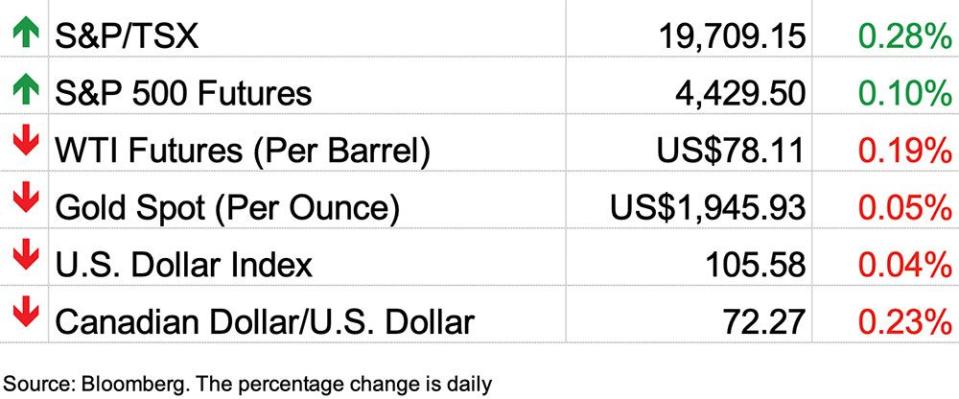Posthaste: These provinces have felt the most pain from Bank of Canada rate hikes


Looking back at the year the Bank of Canada started hiking interest rates, things looked pretty good.
Canada’s real gross domestic product grew 3.8 per cent in 2022, with GDP rising in nine provinces. Saskatchewan led the pack with 6 per cent growth, followed by Alberta, at 5 per cent, according to provincial numbers released last week by Statistics Canada.
But while growth looked good on the surface, Marc Desormeaux, principal economist at Desjardins, spots several “troubling details” in the data that showed the early impacts of the most aggressive interest-rate hiking cycle in recent history.
In an effort to curb soaring inflation after the pandemic, the Bank of Canada raised its policy interest rate from 0.25 to 4.25 per cent in 2022. Three more rate hikes in 2023 brought the rate to the current 5 per cent.
“We already knew how much of a drag housing posed at the national level last year as interest rates rose sharply, but the breadth of weakness and depth in some regions was striking,” said Desormeaux in a note.
After hitting record-highs in 2021, housing investment dropped 12.1 per cent in 2022, falling in seven provinces, a count only exceeded during severe recessions in the past, he said.
Residential capital’s share of economic output in 2022 was below the average of the decade before the pandemic everywhere except in the Maritimes.
In Ontario, Quebec and British Columbia, this investment fell by more than at any point since the 1990s.
In Ontario and B.C., the economies where the housing market holds the biggest sway, growth would have been over 5 per cent if it was not for the decline in real estate, said Desormeaux. As it was, 2022 GDP for Ontario came in at 3.9 per cent and 3.8 per cent for B.C.
Home sales in these two provinces fell sharply as interest rates climbed. When the Bank of Canada paused rates at 4.50 per cent in early 2023, the market experienced a robust recovery that surprised economists. However, the decline resumed when the Bank hiked rates again in June and July, bringing the rate to 5 per cent.
Interest rates have been on pause since then, but Desjardins sees less chance of a rebound this time.
Higher borrowing costs have made the housing market even more unaffordable, and the “higher for longer” narrative from central banks will keep fixed mortgage rates elevated until the Bank of Canada cuts rates next year, said Desormeaux.
Another warning sign from 2022 was savings rates. The pile of money Canadians put away during the pandemic initially shielded consumers from the effects of high inflation and interest rates, but there were already signs that year that that defence was weakening.
Canada’s household saving rate dropped from 10.5 per cent in 2021 to 5.4 per cent in 2022, as higher spending exceeded gains in income, said Statistics Canada.
Ontario saw the steepest decline, falling to 3.2 per cent, mainly because of higher interest payments.
“In fact, households in this province had the highest debt service ratio in the country (8.1 per cent compared with 6.8 per cent for Canada), mainly because of increases in mortgage debt,” said Statistics Canada.
Meanwhile, Saskatchewan was the only province that saw its savings rate improve, rising to 8.7 per cent as incomes were boosted by improved crop conditions and higher grain prices.
Even though the provincial GDP data is a year behind, it still provides “critical takeaways” for growth in 2023 and beyond, said Desormeaux.
The drag from the housing market and risks of greater financial stress in heavily indebted regions such as Ontario and British Columbia reinforces Desjardins’ view that oil-producing provinces such as Alberta are best positioned to weather the downturn.
_____________________________________________________________________
Was this newsletter forwarded to you? Sign up here to get it delivered to your inbox.
_____________________________________________________________________


The records just keep coming in Canada’s rental market. The average asking price for a rental unit has hit new highs now for six months in a row, topping at $2,178 in October.
Vancouver is still the most expensive city for renters, with the average one-bedroom listing at $2,872, almost 7 per cent higher than last year. Toronto is a close second with a one-bedroom fetching $2,607.
But national rent inflation is actually being fuelled mainly by price increases in Alberta, Quebec and Nova Scotia. Rent in Calgary has jumped 14 per cent year over year to $1,733.
Ontario showed the slowest annual growth in apartment rents during October, rising 4.6 per cent to $2,492, said the data released by Rentals.ca and Urbanation Monday.
John Graham, chief executive of CPP Investments, will deliver an update on the performance of the Canada Pension Plan Fund in Calgary, followed by a fireside chat with Deborah Yedlin of the Calgary Chamber of Commerce.
Open Text Corporation takes part in the RBC Capital Markets Global Technology, Internet, Media and Telecommunications Conference in New York
Today’s Data: U.S. consumer price index and NFIB Small Business Economic Trends Survey
Earnings: CAE, Home Depot, Birchcliff Energy, Premium Brands Holdings
Get all of today’s top breaking stories as they happen with the Financial Post’s live news blog, highlighting the business headlines you need to know at a glance.

_______________________________________________________
Does your tax adviser know the rules? Probably not, which is why reform is needed
Tax windfalls dwindle, wages mount: Many provinces feel fiscal pinch as spring budget optimism fades
Business between Canada and India continues despite tensions, says envoy
Retirement is the pinnacle of most Canadians’ financial plans. But the financial industry’s emphasis on investing means there can be a tendency to overlook alternative strategies that can make retirees better off when they stop working. Financial planner Jason Heath outlines six of these that can help you achieve the best retirement possible.
____________________________________________________
Today’s Posthaste was written by Pamela Heaven, @pamheaven, with additional reporting from The Canadian Press, Thomson Reuters and Bloomberg.
Have a story idea, pitch, embargoed report, or a suggestion for this newsletter? Email us at posthaste@postmedia.com, or hit reply to send us a note.
Bookmark our website and support our journalism: Don’t miss the business news you need to know — add financialpost.com to your bookmarks and sign up for our newsletters here.

 Yahoo Finance
Yahoo Finance 



